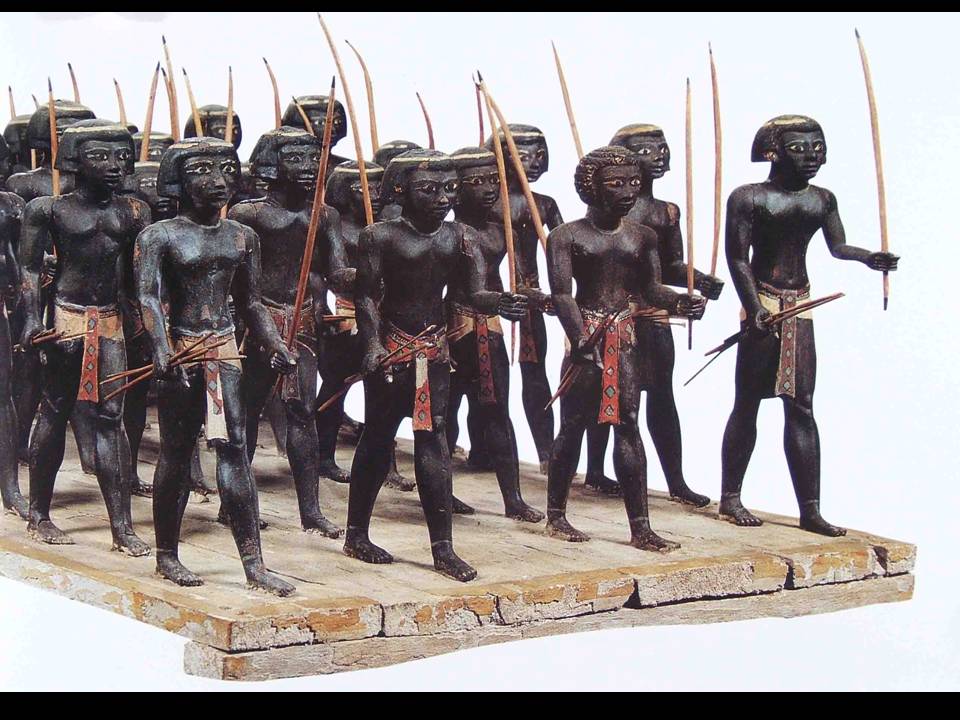The Model of Ancient Egyptian Soldiers, dating back to the Middle Kingdom, 11th Dynasty (circa 2000 BC), offers a unique and fascinating insight into the military structure, life, and significance of ancient Egypt. Unearthed from the tomb of Mesehti at Asyut, this finely crafted model serves as a visual testament to the pivotal role the military played in both the political and social fabric of Egypt during this transformative period. Currently housed in the Grand Egyptian Museum (JE 30986), the model provides an invaluable look at the military forces that were central to Egypt’s stability, defense, and territorial expansion.
A Rare Glimpse into the Egyptian Military
The model vividly portrays soldiers in their distinctive attire, providing a detailed snapshot of what military life may have been like more than 3,000 years ago. The figures, meticulously crafted with attention to every small detail, depict soldiers in various postures, demonstrating the diverse roles they played within Egypt’s armed forces. Each soldier is equipped with weapons such as spears, shields, and bows—tools that were crucial for both defense and offensive campaigns. In addition, their clothing and armor are skillfully rendered, offering a deeper understanding of the military uniform and equipment used during the Middle Kingdom.

Beyond its artistic value, the model gives us an extraordinary glimpse into the hierarchical and organizational structure of Egypt’s military during this period. It helps us understand how soldiers were equipped, their role in the army, and the system that governed their training and deployment. These figures are not simply ornamental but serve as a tool for historians and archaeologists to reconstruct the daily life and operational strategies of ancient Egyptian soldiers.
The Military’s Role in Egypt’s Power and Stability
The soldiers depicted in this model were not merely warriors; they were the backbone of the Egyptian state. During the Middle Kingdom, Egypt was experiencing a phase of consolidation following periods of internal turmoil. The Middle Kingdom (circa 2055–1650 BC) marked an era of political stability and territorial expansion, and the military played a central role in securing Egypt’s borders, maintaining control over conquered lands, and defending the kingdom from foreign invasions. Soldiers were critical to the success of the state’s military campaigns and the extension of Egypt’s influence across the region.

The Middle Kingdom military also performed essential administrative and law enforcement roles, safeguarding Egypt’s culture and values. Their responsibilities were not limited to warfare but extended to managing internal stability and ensuring the welfare of the nation. This model captures not just the aesthetics of their weapons and uniforms but reflects the broader function of the military as a key institution within the Egyptian state apparatus.
Craftsmanship and Artistic Sophistication
The precision and level of detail seen in the model are hallmarks of ancient Egyptian artistry. The craftsmanship speaks to the highly developed skills of the artisans who created these representations. Every element, from the soldiers’ posture to their equipment, is meticulously designed. The fine detailing on the armor, weapons, and faces of the figures demonstrates a deep understanding of human anatomy and motion, showcasing the sophistication of Egyptian craftsmanship.

The model also serves as an important cultural artifact, highlighting the Egyptians’ ability to combine functionality with artistry. The intricate representation of the soldiers reflects the Egyptians’ high regard for the military as an essential pillar of society and a symbol of royal authority. Through these figures, we can appreciate not only their artistic talent but also the significance they attached to their military and the role it played in preserving the nation’s power.
A Window into the Past: Understanding Egyptian Military Organization
In addition to its artistic value, this model is an important tool for understanding the organization and structure of the Egyptian military. The Middle Kingdom marked a time when Egypt’s military was increasingly professionalized, with soldiers serving as a standing force rather than temporary conscripts. The model likely represents a unit of specialized soldiers, offering a snapshot of how the army was divided and how they operated as part of a larger military and administrative system.

The model’s depiction of various weapons also reveals much about Egyptian military strategy and tactics. The bow, for example, was a staple weapon in the Egyptian military, essential for both long-range attacks and close combat. The use of spears and shields further emphasizes the focus on both offense and defense, highlighting the versatile nature of the Egyptian soldier during this era.
Conclusion: The Model’s Significance in Understanding Ancient Egypt
In essence, the Model of Ancient Egyptian Soldiers is more than just an artistic relic. It provides a rare and invaluable opportunity to understand the military organization, weaponry, and social dynamics of one of the world’s greatest ancient civilizations. This artifact offers a direct connection to the past, allowing us to see not just the soldiers’ attire and equipment but also the broader role that the military played in Egypt’s power, culture, and governance.
Through this remarkable model, we gain insight into the Egyptian military system and its crucial role in the stability and expansion of Egypt during the Middle Kingdom. It serves as a reminder of the extraordinary achievements of ancient Egyptian craftsmanship and provides a tangible connection to a pivotal moment in history, giving us a better understanding of the complex and sophisticated society that shaped one of the world’s greatest empires.

